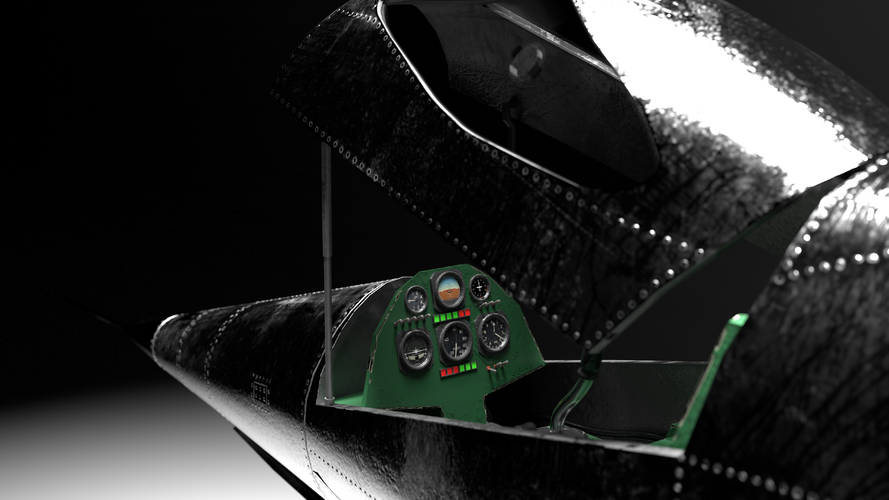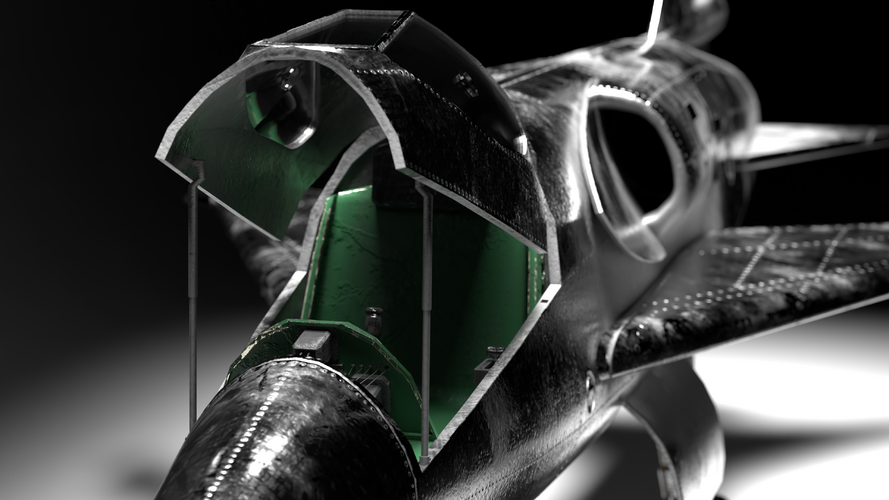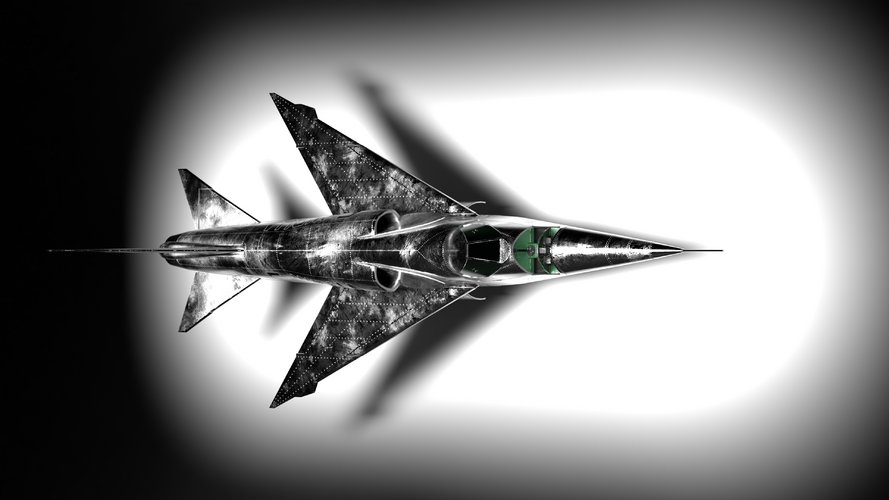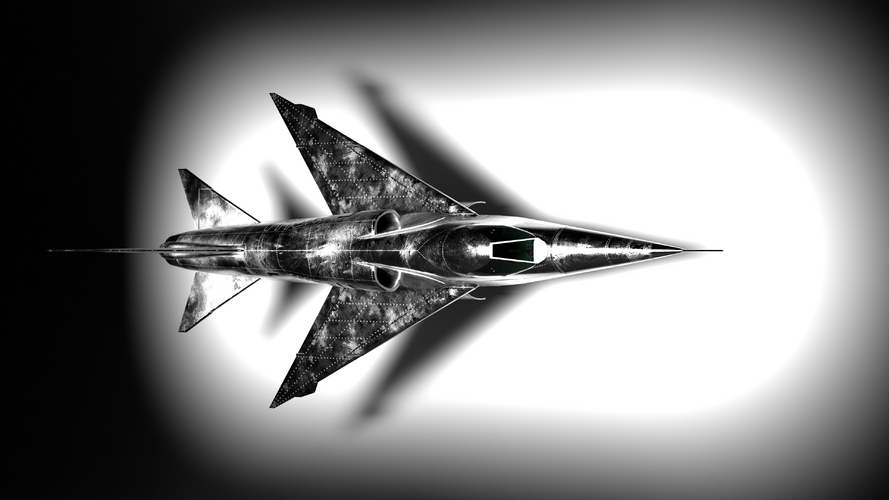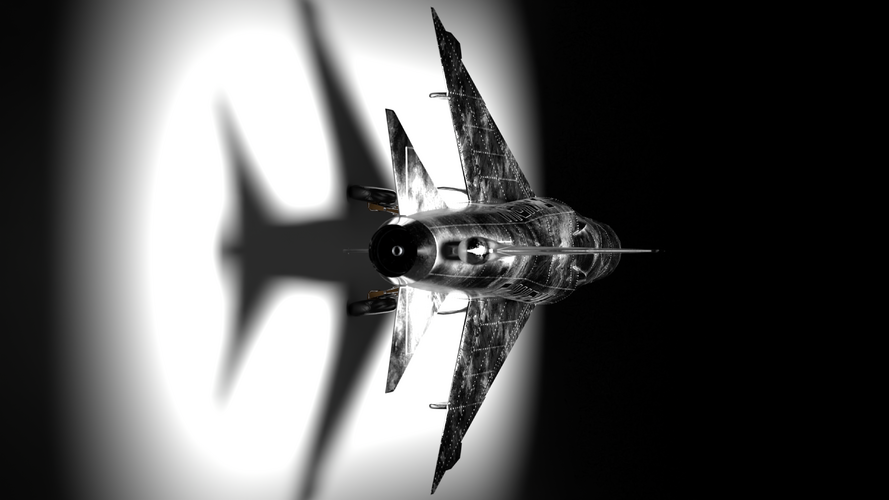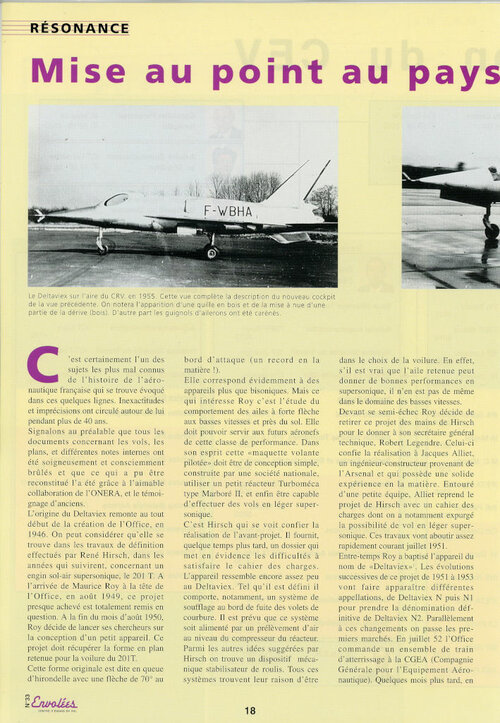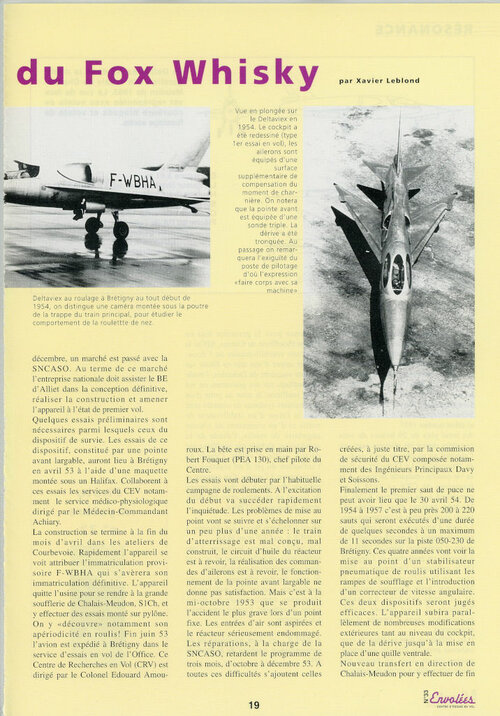You are using an out of date browser. It may not display this or other websites correctly.
You should upgrade or use an alternative browser.
You should upgrade or use an alternative browser.
SNCASO-ONERA « Deltaviex »
- Thread starter hesham
- Start date
- Joined
- 11 March 2006
- Messages
- 8,624
- Reaction score
- 3,792
Hi Hesham,
you're probably speaking of the SNCASO ONERA Deltaviex, which,
belying its name, wasn't a delta, but a swept wing a/c .( And it was
actually built, so it's a little bit OT here ! : )
)
It is said,that it had three different canopies during its existence, but
I know just the two, shown below. If anybody has photos of the third
variant ..... ?
you're probably speaking of the SNCASO ONERA Deltaviex, which,
belying its name, wasn't a delta, but a swept wing a/c .( And it was
actually built, so it's a little bit OT here ! :
It is said,that it had three different canopies during its existence, but
I know just the two, shown below. If anybody has photos of the third
variant ..... ?
Attachments
- Joined
- 11 March 2006
- Messages
- 8,624
- Reaction score
- 3,792
First, my still quite bad understanding of the french language (I promise,
I'll try to learn more next year ! ) has kept me from noticing, that in
) has kept me from noticing, that in
fact "Deltaviex" is just the pronounciation of Delta VX, which is given in
RAF Flying Review as official designation, too !
And there's a photo of a wind tunnel model, which is said to show "entirely
re-designed wings and unusual wingtip control surfaces".But in fact, dense
as I am, I really can't see anything different in comparison to the flown
design. Can somebody set me straight, please ?
A photo of the later configuration is shown, too, so in my opinion the short
notice must refer to other changes .. ???
I'll try to learn more next year !
fact "Deltaviex" is just the pronounciation of Delta VX, which is given in
RAF Flying Review as official designation, too !
And there's a photo of a wind tunnel model, which is said to show "entirely
re-designed wings and unusual wingtip control surfaces".But in fact, dense
as I am, I really can't see anything different in comparison to the flown
design. Can somebody set me straight, please ?
A photo of the later configuration is shown, too, so in my opinion the short
notice must refer to other changes .. ???
Attachments
Matej
Multiuniversal creator
Well, at least I can see a huge difference between the first two and the third picture  Is there any connection or just "click on a bad place"?
Is there any connection or just "click on a bad place"?
Matej
Multiuniversal creator
Ugh. Once again I fell into some sort of test. Beeeeeeeeeee......... 
- Joined
- 27 December 2005
- Messages
- 17,742
- Reaction score
- 26,324
From Tony Buttler
Air International Volume 28 Number 2 February 1985 has a photograph and a brief half page description in its "Plane Facts" column. I can scan and post this tonight.
Any other sources?
Can anyone recommend a good English language source - or any source - for an accurate history of the French ONERA Deltaviex (VX) research aircraft please? I appreciate that the most accurate is likely to be French language, but time is short in terms of getting a translation. Many thanks indeed.
Tony B.
Air International Volume 28 Number 2 February 1985 has a photograph and a brief half page description in its "Plane Facts" column. I can scan and post this tonight.
Any other sources?
- Joined
- 27 December 2005
- Messages
- 17,742
- Reaction score
- 26,324
http://pics-aeronef.discutfree.com/t3377p10-un-p-tit-tour-au-c-e-v-dans-les-annees-50-60
Le Deltaviex
Par ailleurs, sur le petit avion expérimental « Deltaviex » de l’ONERA, il s’agissait d’évaluer les performances aux basses vitesses sur une configuration d’aile à grande flèche en forme de « queue d’hirondelle», réputée avantageuse par le calcul aux grands Mach supersoniques.
C’était typiquement une fausse bonne idée et les premiers « sauts de puce » au C.R.V./ONERA à Brétigny firent apparaître une très dangereuse instabilité du contrôle en roulis rendant l’avion impilotable. Quelques années auparavant, nous avions justement étudié le contrôle de circulation par soufflage au bord de fuite permettant en particulier de contrôler le roulis « au robinet » distribuant l’une ou l’autre rampe de soufflage au bord de fuite : on avait d’ailleurs bricolé une telle rampe sur le vieux bimoteur du C.R.V. et on s’était bien amusé à piloter le roulis de l’avion en ouvrant les robinets d’une bouteille d’air comprimé montée derrière le pilote ! On retint donc cette idée pour « guérir » le Deltaviex : ici les deux rampes de soufflage étaient alimentées par prélèvement sur le petit réacteur Turboméca ; le dispositif était commandé par un simple gyromètre.
Les vols avec ce contrôle automatique furent un plein succès lors de nombreux « sauts de puce » avec enregistrement d’un remarquable amortissement de roulis. Malheureusement, l’avion ne put jamais réaliser de « vrais » vols pour deux bonnes raisons : il n’y avait pas de siège éjectable, le fuselage ayant été dessiné autour du gabarit de notre cher pilote FOUQUET ; d’où interdiction de voler par les services officiels ; d’autre part une panne de moteur entraînait l’arrêt du contrôle par soufflage : deux bonnes raisons pour une fin catastrophique.
En fait, la fin du « Deltaviex » se passa à Modane, où il fut monté en « vraie grandeur », et en fonctionnement, dans la grande soufflerie pour obtenir des comparaisons avec le vol. Quelques années plus tard, il fut cédé à un ferrailleur, et découvert dans une décharge par des « fanas d’aviation » qui vont essayer cette année de le reconstituer pour le futur musée de l’air de Toulouse.
For those interested, here are some details on the Deltaviex. It is taken from the letter of the AAF Ph devoted to Poisson-Quinton A major researchers in aeronautics Deltaviex Moreover, the small experimental aircraft "Deltaviex" of ONERA, it was to evaluate the performance at low speeds on a wing configuration at large arrow-shaped "tail swallow", deemed advantageous by calculating the large supersonic Mach. It was typically a false good idea and the first "smart feeds" the CRV / ONERA Brétigny made to appear a very dangerous instability of the roll control impilotable making the plane. A few years ago we had just studied the traffic control by blowing at the trailing edge allowing in particular to control the roll "to tap" distributing any blower strip at the trailing edge: it was also cobbled together such a ramp on the old twin of CRV and it was great fun to drive the roll of the aircraft by opening the taps of a compressed air cylinder mounted behind the driver! So we kept that idea to "cure" the Deltaviex: here the two ramps were supplied by the blowing out of the small reactor Turbomeca, the device was controlled by a simple gyroscope. Flights with the automatic control was a success in many "jumping flea" with a remarkable record of roll damping. Unfortunately, the aircraft could never achieve "real" flights for two reasons: there was no ejection seat, the fuselage was designed around the size of our dear driver FOUQUET, hence ban to fly by official services, and second engine failure resulted in discontinuation of control Blow: two good reasons for a catastrophic end. In fact, the end of "Deltaviex" happened at Modane, where it was mounted in "real magnitude ", and running in the large wind tunnel for comparison with the flight. A few years later, he was transferred to a scrap dealer, and discovered in a landfill by "aviation enthusiasts" who will try this year to rebuild for the future air museum in Toulouse.
Le Deltaviex
Par ailleurs, sur le petit avion expérimental « Deltaviex » de l’ONERA, il s’agissait d’évaluer les performances aux basses vitesses sur une configuration d’aile à grande flèche en forme de « queue d’hirondelle», réputée avantageuse par le calcul aux grands Mach supersoniques.
C’était typiquement une fausse bonne idée et les premiers « sauts de puce » au C.R.V./ONERA à Brétigny firent apparaître une très dangereuse instabilité du contrôle en roulis rendant l’avion impilotable. Quelques années auparavant, nous avions justement étudié le contrôle de circulation par soufflage au bord de fuite permettant en particulier de contrôler le roulis « au robinet » distribuant l’une ou l’autre rampe de soufflage au bord de fuite : on avait d’ailleurs bricolé une telle rampe sur le vieux bimoteur du C.R.V. et on s’était bien amusé à piloter le roulis de l’avion en ouvrant les robinets d’une bouteille d’air comprimé montée derrière le pilote ! On retint donc cette idée pour « guérir » le Deltaviex : ici les deux rampes de soufflage étaient alimentées par prélèvement sur le petit réacteur Turboméca ; le dispositif était commandé par un simple gyromètre.
Les vols avec ce contrôle automatique furent un plein succès lors de nombreux « sauts de puce » avec enregistrement d’un remarquable amortissement de roulis. Malheureusement, l’avion ne put jamais réaliser de « vrais » vols pour deux bonnes raisons : il n’y avait pas de siège éjectable, le fuselage ayant été dessiné autour du gabarit de notre cher pilote FOUQUET ; d’où interdiction de voler par les services officiels ; d’autre part une panne de moteur entraînait l’arrêt du contrôle par soufflage : deux bonnes raisons pour une fin catastrophique.
En fait, la fin du « Deltaviex » se passa à Modane, où il fut monté en « vraie grandeur », et en fonctionnement, dans la grande soufflerie pour obtenir des comparaisons avec le vol. Quelques années plus tard, il fut cédé à un ferrailleur, et découvert dans une décharge par des « fanas d’aviation » qui vont essayer cette année de le reconstituer pour le futur musée de l’air de Toulouse.
For those interested, here are some details on the Deltaviex. It is taken from the letter of the AAF Ph devoted to Poisson-Quinton A major researchers in aeronautics Deltaviex Moreover, the small experimental aircraft "Deltaviex" of ONERA, it was to evaluate the performance at low speeds on a wing configuration at large arrow-shaped "tail swallow", deemed advantageous by calculating the large supersonic Mach. It was typically a false good idea and the first "smart feeds" the CRV / ONERA Brétigny made to appear a very dangerous instability of the roll control impilotable making the plane. A few years ago we had just studied the traffic control by blowing at the trailing edge allowing in particular to control the roll "to tap" distributing any blower strip at the trailing edge: it was also cobbled together such a ramp on the old twin of CRV and it was great fun to drive the roll of the aircraft by opening the taps of a compressed air cylinder mounted behind the driver! So we kept that idea to "cure" the Deltaviex: here the two ramps were supplied by the blowing out of the small reactor Turbomeca, the device was controlled by a simple gyroscope. Flights with the automatic control was a success in many "jumping flea" with a remarkable record of roll damping. Unfortunately, the aircraft could never achieve "real" flights for two reasons: there was no ejection seat, the fuselage was designed around the size of our dear driver FOUQUET, hence ban to fly by official services, and second engine failure resulted in discontinuation of control Blow: two good reasons for a catastrophic end. In fact, the end of "Deltaviex" happened at Modane, where it was mounted in "real magnitude ", and running in the large wind tunnel for comparison with the flight. A few years later, he was transferred to a scrap dealer, and discovered in a landfill by "aviation enthusiasts" who will try this year to rebuild for the future air museum in Toulouse.
Attachments
- Joined
- 27 December 2005
- Messages
- 17,742
- Reaction score
- 26,324
http://www.aaafasso.fr/DOSSIERSAAAF/DOSS.ACCES_LIBRE/Lettre_acces_libre/Lettres_2004/Lettre_AAAF_n_9_2004.pdf
Par ailleurs, sur le petit avion expérimental « Deltaviex » de l’ONERA, il s’agissait d’évaluer les performances aux
basses vitesses sur une configuration
d’aile à grande flèche en
forme de « queue d’hirondelle », réputée avantageuse par le calcul aux
g r a n d s Ma c h s u p e r s o -
niques. C’était typiquement une fausse bonne
i d é e e t l e s p r emi e r s
« s a u t s d e p u c e » a u
C.R.V./ONERA à Brétigny
firent apparaître une très dangereuse
instabilité du contrôle en roulis rendant
l’avion impilotable. Quelques années
auparavant, nous avions justement étudié le contrôle de circulation par soufflage au bord de fuite permettant en part i c u l i e r d e c o n t r ô l e r l e r o u l i s « a u
robinet » distribuant l’une ou l’autre
rampe de soufflage au bord de fuite : on
avait d’ailleurs bricolé une telle rampe
sur le vieux bimoteur du C.R.V. et on
s’était bien amusé à piloter le roulis de
l’avion en ouvrant les robinets d’une
bouteille d’air comprimé montée derrière le pilote ! On retint donc cette idée
pour « guérir » le Deltaviex : ici les deux
rampes de soufflage étaient alimentées
par prélèvement sur le petit réacteur
Turboméca ; le dispositif était commandé par un simple gyromètre.
Les vols avec ce contrôle automatique
furent un plein succès lors de nombreux
« sauts de puce » avec enregistrement
d’un remarquable amortissement de
roulis. Malheureusement, l’avion ne put
jamais réaliser de « vrais » vols pour
deux bonnes raisons : il n’y avait pas de
siège éjectable, le fuselage ayant été
dessiné autour du gabarit de notre cher
pilote FOUQUET ; d’où interdiction de
voler par les services officiels ; d’autre
part une panne de moteur entraînait l’arrêt du contrôle par soufflage : deux bonnes raisons pour une fin catastrophique.
En fait, la fin du « Deltaviex » se passa à
Modane, où il fut monté en « vraie grandeur », et en fonctionnement, dans la
grande soufflerie pour obtenir des comparaisons avec le vol. Quelques années
plus tard, il fut cédé à un
f e r r a i l l e u r, e t d é c o u v e r t
dans une décharge par des
« fanas d’aviation » qui vont
essayer cette année de le
reconstituer pour le futur
musée de l’air de Toulouse.
Toutes ces études eurent
un certain retentissement international
et amenèrent beaucoup de visiteurs
anglais et américains, à la soufflerie de
Cannes.
Je me souviens que la difficulté pour eux
était de demander un ordre de mission
pour Cannes dont la réputation était
entachée de frivolité, en particulier par
son festival du film, nuisant fâcheusement au sérieux d’un laboratoire !
Cependant, ils vinrent nombreux pendant des années, utilisant quelquefois
leurs week-ends au perfectionnement
de leurs connaissances en aérodynamique de la voile et de l’hydrodynamique
de la plongée sous-marine !
Quelques années plus tard, le même
problème se posa, pour les missions à
Modane durant l’hiver, à cause de l’att r a c t i o n d e s e s s t a t i o n s d e s k i !
Cependant Modane devint certainement
grâce à son patron, Marcel PIERRE,
l’un des centres de recherches aérodynamiques les plus prestigieux du monde,
très accueillant pour les visiteurs et les
constructeurs ; son personnel était fort
motivé pour les essais aérodynamiques,
mais en profitaient aussi pour gagner
toutes les descentes à ski, lors des
week-ends !
La morale de ces histoires est que les
chercheurs sont beaucoup plus efficaces dans un cadre agréable loin de leur
administration centrale…
Moreover, the small experimental aircraft "Deltaviex" of ONERA, it was to evaluate the performance
of a low-speed configuration
of the wing at high arrow
-shaped "tail swallow", deemed beneficial by the to calculate
g Ma ch rand supersonic -
techniques. It was typically a good fake
id é e pr emi ers and
"smart feeds" the
CRV / ONERA Brétigny
did show a very dangerous
instability of the roll control making
the plane impilotable. A few years
ago we had just studied the traffic control by blowing at the trailing edge to cross in part icular O l roll "to
tap "distributing any
blower strip at the trailing edge: it
was Moreover, such a makeshift ramp
on the old twin of CRV and it
was great fun to drive the roll of
the aircraft by opening the taps of a
compressed air cylinder mounted behind the driver! So we kept that idea
to "cure" the Deltaviex: here the two
ramps were fed blowing
out of the small reactor
Turbomeca, the device was controlled by a simple gyroscope.
Flights with the automatic control
was a success in many
"jumping flea" with recording
a remarkable damping
roll. Unfortunately, the aircraft could
never achieve "real" flights for
two reasons: there was no
ejection seat, the fuselage was
designed around the size of our dear
driver FOUQUET, hence ban
by flying the official, on the other
hand an engine failure resulted in discontinuation of control Blow: two good reasons for a catastrophic end.
In fact, the end of "Deltaviex" went to
Modena, where it was mounted in "real magnitude ", and running in the
large wind tunnel for comparison with the flight. A few years
later he was transferred to a
errailleur f, e and covered
in a landfill by
"aviation enthusiasts" who will
try this year to
rebuild for the future
air museum in Toulouse.
All these studies had
some international impact
and brought many visitors
and American English, the blower
Cannes.
I remember the difficulty for them
was to ask a travel order
to Cannes whose reputation was
tainted by frivolity, especially through
its festival the film, unfortunately seriously damaging a laboratory!
However, they came for many years, sometimes using
their weekends to the development
of their knowledge of aerodynamics and hydrodynamics sailing
scuba diving!
Some Years later, the same
problem arose, for missions
Modane in the winter because of the att raction of its ski resorts
but certainly became Modane
with his boss, Marcel PIERRE,
one of the centers aerodynamic research the most prestigious in the world,
very welcoming to visitors and
manufacturers; staff was very
motivated for aerodynamic testing,
but also took advantage to win
all downhill skiing during the
weekends!
The moral of these stories is that
researchers are much more efficient in pleasant surroundings away from their
headquarters ...
Par ailleurs, sur le petit avion expérimental « Deltaviex » de l’ONERA, il s’agissait d’évaluer les performances aux
basses vitesses sur une configuration
d’aile à grande flèche en
forme de « queue d’hirondelle », réputée avantageuse par le calcul aux
g r a n d s Ma c h s u p e r s o -
niques. C’était typiquement une fausse bonne
i d é e e t l e s p r emi e r s
« s a u t s d e p u c e » a u
C.R.V./ONERA à Brétigny
firent apparaître une très dangereuse
instabilité du contrôle en roulis rendant
l’avion impilotable. Quelques années
auparavant, nous avions justement étudié le contrôle de circulation par soufflage au bord de fuite permettant en part i c u l i e r d e c o n t r ô l e r l e r o u l i s « a u
robinet » distribuant l’une ou l’autre
rampe de soufflage au bord de fuite : on
avait d’ailleurs bricolé une telle rampe
sur le vieux bimoteur du C.R.V. et on
s’était bien amusé à piloter le roulis de
l’avion en ouvrant les robinets d’une
bouteille d’air comprimé montée derrière le pilote ! On retint donc cette idée
pour « guérir » le Deltaviex : ici les deux
rampes de soufflage étaient alimentées
par prélèvement sur le petit réacteur
Turboméca ; le dispositif était commandé par un simple gyromètre.
Les vols avec ce contrôle automatique
furent un plein succès lors de nombreux
« sauts de puce » avec enregistrement
d’un remarquable amortissement de
roulis. Malheureusement, l’avion ne put
jamais réaliser de « vrais » vols pour
deux bonnes raisons : il n’y avait pas de
siège éjectable, le fuselage ayant été
dessiné autour du gabarit de notre cher
pilote FOUQUET ; d’où interdiction de
voler par les services officiels ; d’autre
part une panne de moteur entraînait l’arrêt du contrôle par soufflage : deux bonnes raisons pour une fin catastrophique.
En fait, la fin du « Deltaviex » se passa à
Modane, où il fut monté en « vraie grandeur », et en fonctionnement, dans la
grande soufflerie pour obtenir des comparaisons avec le vol. Quelques années
plus tard, il fut cédé à un
f e r r a i l l e u r, e t d é c o u v e r t
dans une décharge par des
« fanas d’aviation » qui vont
essayer cette année de le
reconstituer pour le futur
musée de l’air de Toulouse.
Toutes ces études eurent
un certain retentissement international
et amenèrent beaucoup de visiteurs
anglais et américains, à la soufflerie de
Cannes.
Je me souviens que la difficulté pour eux
était de demander un ordre de mission
pour Cannes dont la réputation était
entachée de frivolité, en particulier par
son festival du film, nuisant fâcheusement au sérieux d’un laboratoire !
Cependant, ils vinrent nombreux pendant des années, utilisant quelquefois
leurs week-ends au perfectionnement
de leurs connaissances en aérodynamique de la voile et de l’hydrodynamique
de la plongée sous-marine !
Quelques années plus tard, le même
problème se posa, pour les missions à
Modane durant l’hiver, à cause de l’att r a c t i o n d e s e s s t a t i o n s d e s k i !
Cependant Modane devint certainement
grâce à son patron, Marcel PIERRE,
l’un des centres de recherches aérodynamiques les plus prestigieux du monde,
très accueillant pour les visiteurs et les
constructeurs ; son personnel était fort
motivé pour les essais aérodynamiques,
mais en profitaient aussi pour gagner
toutes les descentes à ski, lors des
week-ends !
La morale de ces histoires est que les
chercheurs sont beaucoup plus efficaces dans un cadre agréable loin de leur
administration centrale…
Moreover, the small experimental aircraft "Deltaviex" of ONERA, it was to evaluate the performance
of a low-speed configuration
of the wing at high arrow
-shaped "tail swallow", deemed beneficial by the to calculate
g Ma ch rand supersonic -
techniques. It was typically a good fake
id é e pr emi ers and
"smart feeds" the
CRV / ONERA Brétigny
did show a very dangerous
instability of the roll control making
the plane impilotable. A few years
ago we had just studied the traffic control by blowing at the trailing edge to cross in part icular O l roll "to
tap "distributing any
blower strip at the trailing edge: it
was Moreover, such a makeshift ramp
on the old twin of CRV and it
was great fun to drive the roll of
the aircraft by opening the taps of a
compressed air cylinder mounted behind the driver! So we kept that idea
to "cure" the Deltaviex: here the two
ramps were fed blowing
out of the small reactor
Turbomeca, the device was controlled by a simple gyroscope.
Flights with the automatic control
was a success in many
"jumping flea" with recording
a remarkable damping
roll. Unfortunately, the aircraft could
never achieve "real" flights for
two reasons: there was no
ejection seat, the fuselage was
designed around the size of our dear
driver FOUQUET, hence ban
by flying the official, on the other
hand an engine failure resulted in discontinuation of control Blow: two good reasons for a catastrophic end.
In fact, the end of "Deltaviex" went to
Modena, where it was mounted in "real magnitude ", and running in the
large wind tunnel for comparison with the flight. A few years
later he was transferred to a
errailleur f, e and covered
in a landfill by
"aviation enthusiasts" who will
try this year to
rebuild for the future
air museum in Toulouse.
All these studies had
some international impact
and brought many visitors
and American English, the blower
Cannes.
I remember the difficulty for them
was to ask a travel order
to Cannes whose reputation was
tainted by frivolity, especially through
its festival the film, unfortunately seriously damaging a laboratory!
However, they came for many years, sometimes using
their weekends to the development
of their knowledge of aerodynamics and hydrodynamics sailing
scuba diving!
Some Years later, the same
problem arose, for missions
Modane in the winter because of the att raction of its ski resorts
but certainly became Modane
with his boss, Marcel PIERRE,
one of the centers aerodynamic research the most prestigious in the world,
very welcoming to visitors and
manufacturers; staff was very
motivated for aerodynamic testing,
but also took advantage to win
all downhill skiing during the
weekends!
The moral of these stories is that
researchers are much more efficient in pleasant surroundings away from their
headquarters ...
- Joined
- 27 December 2005
- Messages
- 17,742
- Reaction score
- 26,324
Attachments
- Joined
- 27 December 2005
- Messages
- 17,742
- Reaction score
- 26,324
Attachments
- Joined
- 27 December 2005
- Messages
- 17,742
- Reaction score
- 26,324
Note the different canopy designs....
- Joined
- 11 March 2006
- Messages
- 8,624
- Reaction score
- 3,792
We had the Deltaviex here before http://www.secretprojects.co.uk/forum/index.php/topic,441.msg5237.html#msg5237,
and although I cannot tell in the moment, where I read, that there were three
different canopies, maybe the the third was of the type shown on the model ?
Of course, this probably would have meant, that dwarfs would have been needed
as pilots.
(photo is a cutout from J.-C. Fayer Vols d'Essay)
and although I cannot tell in the moment, where I read, that there were three
different canopies, maybe the the third was of the type shown on the model ?
Of course, this probably would have meant, that dwarfs would have been needed
as pilots.
(photo is a cutout from J.-C. Fayer Vols d'Essay)
Attachments
- Joined
- 27 December 2005
- Messages
- 17,742
- Reaction score
- 26,324
Plane Facts, Air International Vol 28 No 2 (Feb 1985)
Illustrated with two pics already posted -


The Deltaviex was an intriguing aerodynamic research aircraft designed by an ONERA team lead by Ing Aliette and built in 1953 by the SNCASO. Powered by a 400kgp Turbomeca Marbore II turbojet, the Deltaviex (F-WBHA) was intended to test several new ideas in control. Its six per cent thickness delta wing featured 70 deg leading edge sweep and a span of only 3.4m, total area being some 5 sq m. The tailplane, which was also of delta form, was adjustable from +1 deg to -4deg and the elevators, like the ailerons, were aerodynamically horn-balanced. The loaded weight of the Deltaviex was 920kg. Boundary layer control was used on the inner portions of the wings and was achieved by bleeding two per cent of the output of the Marbore II's compressor and blowing the air out through the flaps, this being the first application of the jet flap principle as opposed to the blown flap. The amount of air blown could be varied between each flap and lateral control thus being obtained by use of differential pressure. Orthodox ailerons were fitting for low speed flight. Considerable testing of the Deltaviex was undertaken in the S1 wind tunnel at Modane before the flight test programme was initiated at Bretigny in 1954 with Robert Fourquet at the controls. The first flight with the air bleed system fully operational was made at Bretigny on 21 September 1955. A considerable number of flight tests were undertaken with the Deltaviex and at one time consideration was given to replacing the delta wing planform with one employing sharply swept pointed wings with wingtip ailerons. However this plan was not pursued.
Illustrated with two pics already posted -
- Joined
- 11 March 2006
- Messages
- 8,624
- Reaction score
- 3,792
"... and at one time consideration was given to replacing the delta wing planform with one employing sharply swept pointed wings with wingtip ailerons. However this plan was not pursued."
That's puzzling me, as I've never saw the Deltaviex with a real delta wing and with other than wingtip ailerons.
Actually, the only changes I can recognise in the model are the more slender nose and obviously the deletion
of the intakes, but the aerodynamical layout is still the same.
Perhaps Plane Facts got the chronology mixed up ?
That's puzzling me, as I've never saw the Deltaviex with a real delta wing and with other than wingtip ailerons.
Actually, the only changes I can recognise in the model are the more slender nose and obviously the deletion
of the intakes, but the aerodynamical layout is still the same.
Perhaps Plane Facts got the chronology mixed up ?
- Joined
- 27 December 2005
- Messages
- 17,742
- Reaction score
- 26,324
My thanks to everyone who contributed to my request for info on the ONERA Deltaviex. Much appreciated and I have enough now to put together a few hundred words for European X-Planes. However, does anyone have a high res (300dpi) scan of one of the original photos please? Very best wishes to all. Tony.
- Joined
- 28 January 2008
- Messages
- 635
- Reaction score
- 511
I saw the Deltaviex (F-WBHA) last summer while visiting Ailes Anciennes Toulouse. It was in the restoration hangar with a French language information board.
Apologies for the horizontal placard image but I could not work out how to retain the portrait layout of the original!
[Image rotated by forum admins]
Apologies for the horizontal placard image but I could not work out how to retain the portrait layout of the original!
[Image rotated by forum admins]
Attachments
Last edited by a moderator:
- Joined
- 11 March 2012
- Messages
- 3,247
- Reaction score
- 3,176
My dear Jemiba,
Those “wingtip control surfaces” look like ailerons similar to those i installed on English Electric Lightnings.
While they look almost triangular, they have a short, span-wise section containing the hinge. Controll surfaces work best when the hinge line is perpendicular to airflow. The triangle forward of the hinge line looks to be about 1/4 the area of the aft portion .... great for balancing aerodynamic loads and lightening control stick forces.
We suspect that the text was referring to the bleed air control valves as the innovation.
Those “wingtip control surfaces” look like ailerons similar to those i installed on English Electric Lightnings.
While they look almost triangular, they have a short, span-wise section containing the hinge. Controll surfaces work best when the hinge line is perpendicular to airflow. The triangle forward of the hinge line looks to be about 1/4 the area of the aft portion .... great for balancing aerodynamic loads and lightening control stick forces.
We suspect that the text was referring to the bleed air control valves as the innovation.
it has survived ? a restauration ? nice ! never knew much about this one, pretty obscure. Note the civilian buzz number F-WBHA: ONERA is an aerodynamics laboratory, neither military nor an aircraft company. Why did they build the Deltaviex for the LWF competition is beyond me. LWF already had the TAON Etendard Baroudeur and many many others.
- Joined
- 27 December 2005
- Messages
- 17,742
- Reaction score
- 26,324
Fixed for you.Apologies for the horizontal placard image but I could not work out how to retain the portrait layout of the original!
Easiest way on Windows is to install Irfanview viewer &, plugins, open JPG and use Options - Lossless JPG Rotate function.
- Joined
- 26 May 2006
- Messages
- 34,869
- Reaction score
- 15,733
Attachments
- Joined
- 11 March 2012
- Messages
- 3,247
- Reaction score
- 3,176
While "Delta" may be a miss-nomer here, consider how little true deltas benefit aerodynamically from the straight, center, trailing-edge. Since airflow on deltas is largely defined by the leading edge. Especially at steep angles of attack, sharply swept leading edges produce large wing-tip vortices that define airflow long before it reaches the trailing edge.
The primary function of the center trailing edge is structural to allow a light-weight, simple rear spar to route straight from one wing-tip to the other.
Consider how the successful MiG-21 is configured similar to this SNCASO prototype except for its wings having straight trailing edges.
In conclusion, SNCASO got the aerodynamic concept correct, but it required MiG's expertise to make this configuration successful in battle.
The primary function of the center trailing edge is structural to allow a light-weight, simple rear spar to route straight from one wing-tip to the other.
Consider how the successful MiG-21 is configured similar to this SNCASO prototype except for its wings having straight trailing edges.
In conclusion, SNCASO got the aerodynamic concept correct, but it required MiG's expertise to make this configuration successful in battle.
aircraftstories
I really should change my personal text
- Joined
- 19 February 2012
- Messages
- 3
- Reaction score
- 21

august 2022 - Toulouse.
klem
I really should change my personal text
- Joined
- 7 March 2015
- Messages
- 726
- Reaction score
- 1,633
Acquired by a garage manager in the Toulouse region to make it a commercial sign after its withdrawal from service, the Deltaviex was found in 1984 by the "Association Ailes Anciennes", which reinstated it in its collection in 2015 where a work of restoration was undertaken at "L'Aeroscopia" Aeronautical Museum in Toulouse-Blagnac.-( Association Ailes Anciennes Toulouse - website : https://aatlse.org/fr/appareils/deltaviex ) - https://www.shu-aero.com/AeroPhotos_Shu_Aero/Aircraft_N/Sud_Ouest/ONERA_Deltaviex_F_WBHA_01.html - https://www.jetphotos.com/registration/F-WBHA - https://www.rodbearden.com/France Tour 2013/Page 5/Sud-Ouest Onera Deltaviex F-WBHA 1.html
Attachments
martinbayer
ACCESS: Top Secret
- Joined
- 6 January 2009
- Messages
- 3,385
- Reaction score
- 3,878
To me, even today, this looks like a very elegant aircraft design.
Last edited:
klem
I really should change my personal text
- Joined
- 7 March 2015
- Messages
- 726
- Reaction score
- 1,633
In my opinion, the person to blame is the one who decided to give it to a garage manager instead of a museum because it is a unique prototype. It is clear that the preservation of a valuable heritage is the last concern for this person because she only saw a pile of scrap metal there.Nice to have that old and rare jet in the (good) hands of Ailes anciennes / Aeroscopia.
Note that Aeroscopia and Ailes Anciennes Toulouse are not the same thing: though located on adjacent lots, Aeroscopia is an Airbus-backed museum (a very good one by the way), which has often used Ailes Anciennes restorations in its display area (the F-104G being a good example). I'm sure there is a mutual agreement between the two, but they are different entities and as far as I've seen the Deltaviex has never been on display at Aeroscopia.
And while I'm talking about it, though I have no association with Ailes Anciennes in Toulouse, I have seen many of their restorations and they are really very good. I hope that one day the Deltaviex will get the full treatment
And while I'm talking about it, though I have no association with Ailes Anciennes in Toulouse, I have seen many of their restorations and they are really very good. I hope that one day the Deltaviex will get the full treatment
Fairahy
ACCESS: Restricted
Hello,
if anyone is interested in this plane, I made a small 3D model of it (using blender). Some details will probably be imperfect, I may modify it one day to make it a little closer to reality, but I find its current appearance rather faithful.

 skfb.ly
If I made mistakes in the model do not hesitate to tell me!
skfb.ly
If I made mistakes in the model do not hesitate to tell me!
Here are some Blender renders of the model you can find on the link

if anyone is interested in this plane, I made a small 3D model of it (using blender). Some details will probably be imperfect, I may modify it one day to make it a little closer to reality, but I find its current appearance rather faithful.

Plane - Deltaviex ONNERA SNCASO - 3D model by Savinien B. (@SavinienBerault)
The Deltaviex was a small French experimental jet aircraft, built by SNCASO for ONERA, the French equivalent of what was, at the time, NACA. It flew from 1954 to 1957. The plane is characterized by its extremely small size and highly swept wings. It was designed to explore the possibility of...
Here are some Blender renders of the model you can find on the link
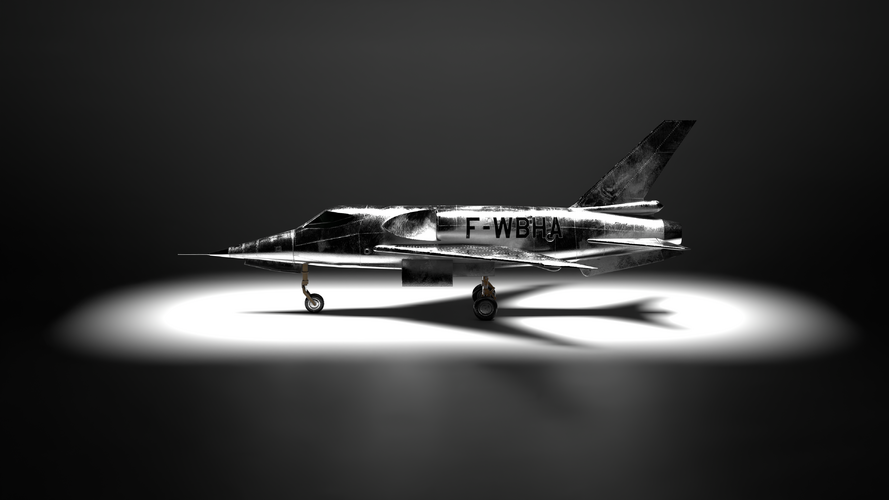
Attachments
Last edited:
- Joined
- 15 February 2024
- Messages
- 500
- Reaction score
- 1,302
When I was working for the CEV 30 years ago, I asked Xavier Leblond to write a short article for the internal magazine "Envolées". Please find it attached.
I will come back with him soon. This is one of the topic I prepare for a more complete history with some surprises and a lot of new information.
I will come back with him soon. This is one of the topic I prepare for a more complete history with some surprises and a lot of new information.
Attachments
Hello,
if anyone is interested in this plane, I made a small 3D model of it (using blender). Some details will probably be imperfect, I may modify it one day to make it a little closer to reality, but I find its current appearance rather faithful.
If I made mistakes in the model do not hesitate to tell me!
Plane - Deltaviex ONNERA SNCASO - 3D model by Savinien B. (@SavinienBerault)
The Deltaviex was a small French experimental jet aircraft, built by SNCASO for ONERA, the French equivalent of what was, at the time, NACA. It flew from 1954 to 1957. The plane is characterized by its extremely small size and highly swept wings. It was designed to explore the possibility of...skfb.ly
Here are some Blender renders of the model you can find on the link
That looks awesome: having seen the actual aircraft many times in Toulouse, I'd say you aced it!
Similar threads
-
Cold War Delta Prototypes: The Fairey Deltas, Convair Century-Series, and Avro 707 by Tony Buttler
- Started by newsdeskdan
- Replies: 15
-
NEWS: Clean engines, wings that fold: Boeing dreams of futuristic jets
- Started by Sentinel Chicken
- Replies: 2
-
-
FLIGHTS OF FANTASY: The Lockheed L-2000 SST in airline service
- Started by Sentinel Chicken
- Replies: 9
-
Shaping the Vulcan: Design and development of Avro's V-Bomber (Stephen Liddle)
- Started by RocketJavelin
- Replies: 5















![F-WBHA_SNCASO-ONERA_Deltaviex_[Toulouse]_Image.JPG](/data/attachments/149/149351-fc334f8d0a71ba4ff69350922597f40a.jpg)
![F-WBHA_SNCASO-ONERA_Deltaviex_[Toulouse]_Info.JPG](/data/attachments/149/149402-ad307c7322c54eb232eb0a617919d6d9.jpg)












